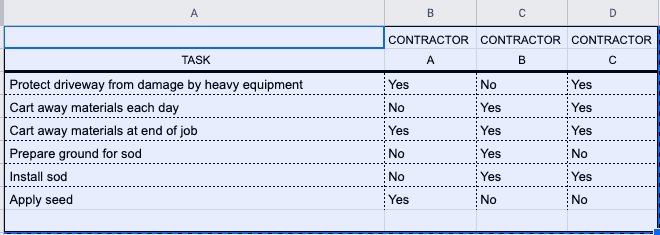7 Best Tips To Get The Perfect Bids From Contractors
Hiring a contractor is usually a bit nerve-wracking. Are they going to be reliable? Do they fully understand exactly what you want done? Will there be any unpleasant surprises along the way?
When you understand how to control the bidding process, I promise, you’ll save TIME, STRESS + MONEY! Follow these simple steps to get the right bids from contractors. And after you’ve received the right bids, you’ll be able to compare apples to apples and to hire the best contractor for your project.
These seven tips are designed to give you the right tools, frame of mind, and confidence to get your project completed.
THIS POST CONTAINS SOME AFFILIATE LINKS FOR YOUR CONVENIENCE (WHICH MEANS IF YOU PURCHASE AFTER CLICKING A LINK I WILL EARN A SMALL COMMISSION, BUT IT WON’T COST YOU A PENNY MORE)! YOU CAN FIND MY FULL PRIVACY AND DISCLOSURE POLICY HERE.
Why is it important to get the right bid?
The right bid is your first step to achieving a successful home improvement project. The right bid isn’t always the lowest bid either.
The first and most important challenge is to make sure that each contractor is pricing out the same job for you. This sounds obvious, but it’s more of a challenge than you might think.
In any home improvement work there are choices. Materials are just one example. One contractor prefers to work with material A and swears by it. Another contractor swears by material B. And that’s just one variable!
How to get the right bids the right way
Follow these simple steps to make sure that when you sign a contract, it includes everything you expect the contractor to do for you.
1 – Establish Your Priorities
Determine your priorities. Is your home improvement project urgent or not time-sensitive. If you have a more urgent project that has to be completed within a certain time frame, be aware that you might end up paying more.
- How flexible is your budget?
- Is there a number in your mind that you can’t exceed?
Make a private list of your budgetary and time constraints. Be clear about what you are will to do on what things you will not compromise on. Don’t share your budget with the contractors.
2 – Define the Scope of Work.
Write out a description of what you want to achieve. Describe the Product not the Process. What does this mean? It means you should focus on describing the end result that you want. Here’s a good simplistic example to illustrate what I mean.
“I want the maple tree in my front yard cut down and taken away by the end of this month. I want the hole filled in and sod put on top so that when the contractor finishes the work no one would know there was ever a tree there.”
That’s the outcome that you want. Obviously, you’re not going to tell a tree surgeon which branches to cut first, what equipment to use or how to prepare for sod.
Just for comparison, here’s a not-so-good illustration: “I want to add these two wall sconces in my Dining Room.”
A better way of describing this would be “I want to add these two sconces in my Dining Room. I will mark the wall where I want them to be. I want them to be on a new switch beside the main switch at the kitchen door. Don’t include the patching and painting. I will patch the sheetrock and do the painting myself.”
The most important thing you can do is to write out what the end result should be.
You may not know all of the steps that have to be taken to complete the job. But you do know what you want the completed product to look like when it’s done.
Write this out in as much detail as you can. When you meet with contractors, give each of them a copy and go through it with them. This way you make sure that everyone is starting out with the same information.
3 – Keep Records
You want to get into this habit right from the start. Take notes during – or right after – every meeting with the contractors.
Each contractor will have her own ideas about how to do the work. Each of them will offer their opinions about the best materials to use and the best product brands to use.
Take note of these suggestions. You might benefit from them.
4 – Organize Your Notes
Gather all of your notes from these meetings. And be sure to include any promotional or informational materials from any of the bidding contractors. Decide how you want to organize your files.
Digital Organization. If you’re using a computer, create a folder with the name of your project. Create sub-folder for each of the contractors and include any information you’ve received digitally in the appropriate folder.
Non-Digital Organization. If you prefer to use a non-digital approach, go out and get an expanding file folder. I recommend to look for a legal sized or an A4 one, because it will help to store odd sized documents better.
5 – Communication
- Create a statement of work.
- List the ORIGINAL scope or work.
- Be sure to include any CHANGES you want to add. Chances are you’ll have picked up some great ideas from talking to several contractors. Make sure to include these new ideas/changes in your email.
Now every contractor has the SAME information. And you can expect to get pricing exactly on what you want. Your contractors will appreciate this clarity.
6 – Compare Your Findings
Once you’ve received the bids you’re ready to compare them. Right here we’re only going to focus on what is included in the bids. Later one you’re going to want to look at things such as their insurance.
Make a list of what each contractor includes in their proposal. A simple spreadsheet works really well for this. The first column is going to have the list of tasks that each contractor includes. The the other columns are just Yes/No tracking entries.

In our example, Contractor A didn’t include sod and instead included just grass seed. If that contractor is the lowest bidder, this might be why.
Contractor B didn’t mention protecting your driveway. Find out why. Sometimes contractors don’t list the things they take for granted. But, you can make sure.
But suppose a contractor didn’t provide any description of the work and just gave you one sentence and a price? That’s not ideal. But you have your notes and your emails. Use them to get what you want. Ask the contractor to confirm that everything that you have listed in your description is included in the price.
Maybe one of the contractors offered to take away a pile of garden waste or accumulated trash in your garage. You might want all of them to include that service. (Hint! Hint! Very often a contractor is more willing to give you an added service than a lower price.)
7 – Summary
- Everyone has the same information.
- And you’ve included the best ideas you’ve uncovered during the process.









